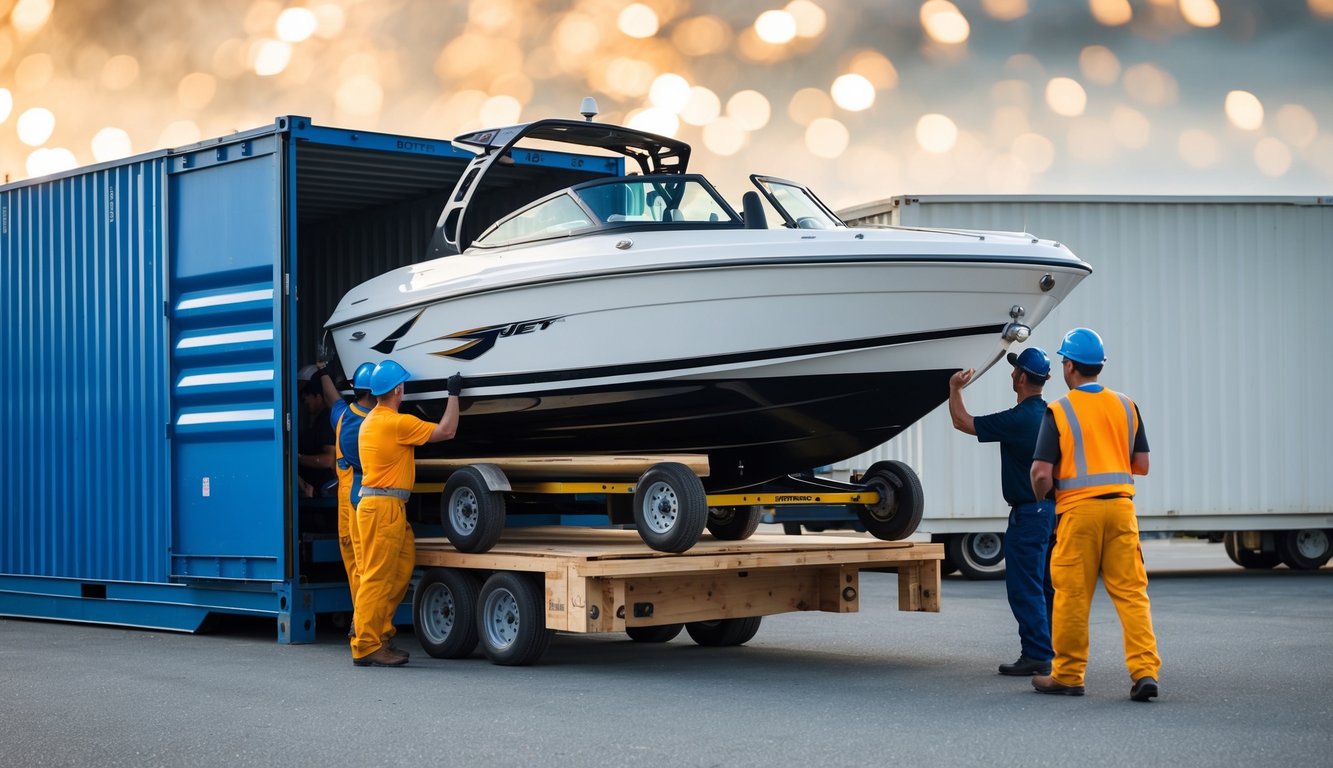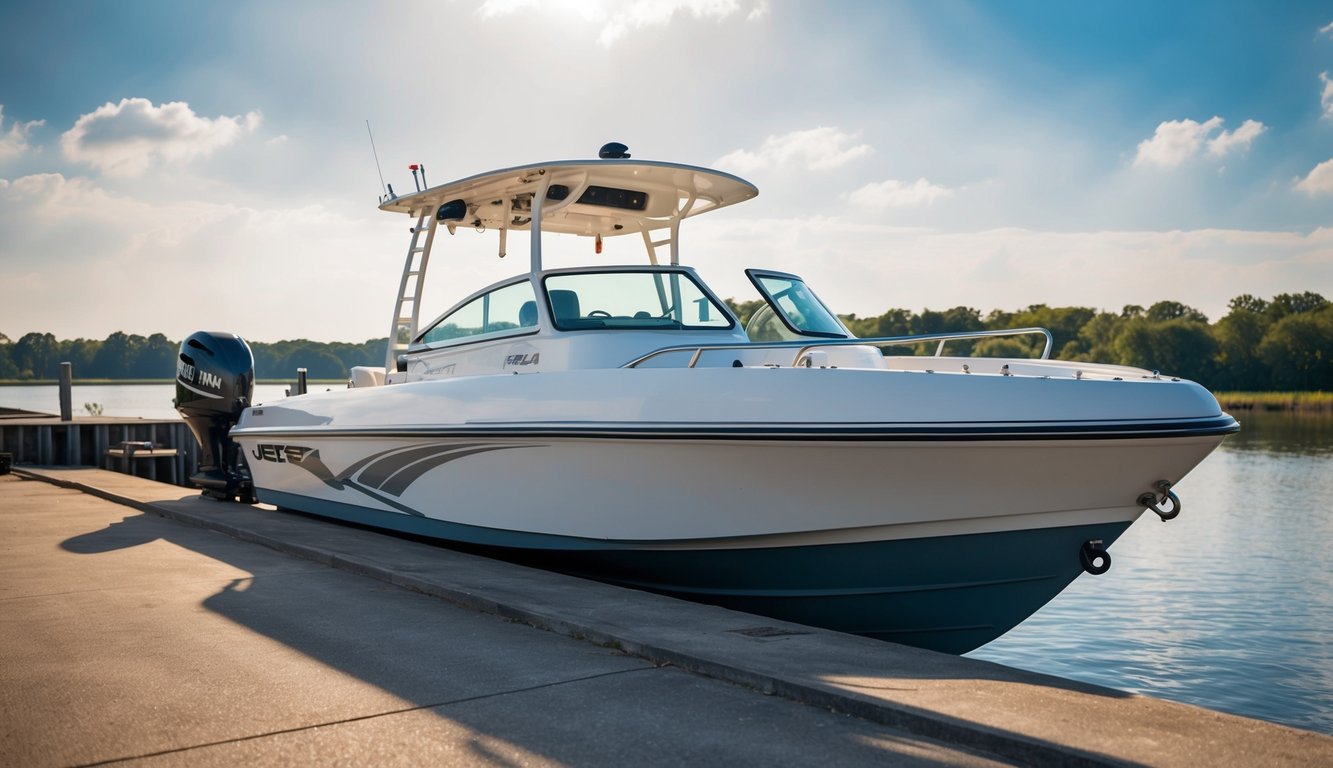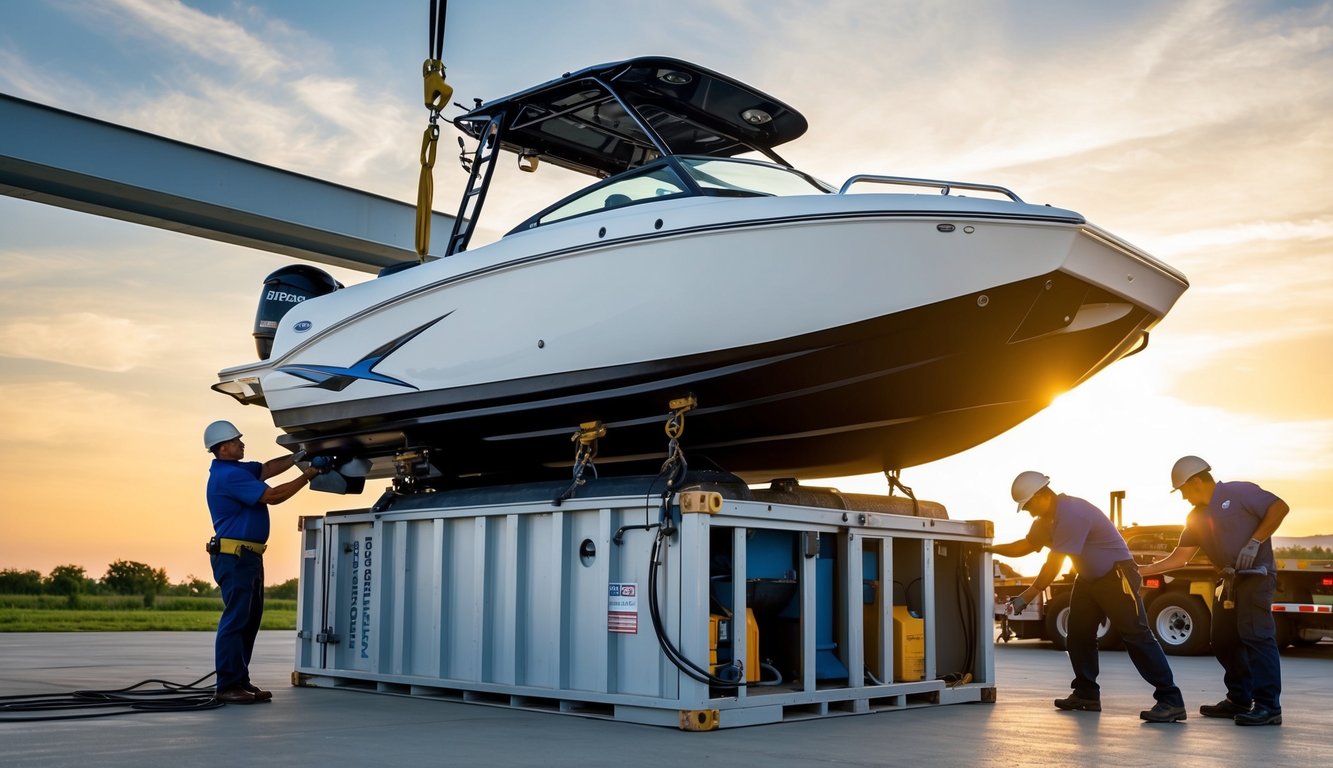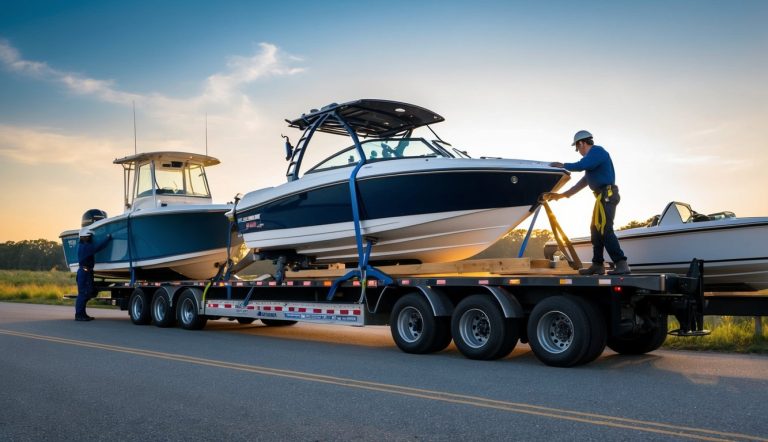Shipping a jet boat requires careful planning and knowledge of best practices. Whether you’re a first-time buyer having your new vessel delivered or a seasoned owner relocating your prized watercraft, understanding the proper procedures can save you time, money, and potential damage. You need to know what steps to take before, during, and after the shipping process.
Proper preparation and clear communication with shipping professionals will ensure your jet boat arrives safely at its destination. From securing loose items to understanding insurance coverage, there are important considerations that shouldn’t be overlooked. Taking the right precautions while avoiding common mistakes will help protect your valuable investment throughout its journey.
Prepare essential paperwork before shipping

- When shipping a jet boat, having the right documents ready is a must. You need to gather proof of ownership, registration, and any required permits or licenses before arranging transportation.
- Your boat’s title and registration papers prove you own the vessel. Keep these documents in a safe folder that you can easily access during the shipping process.
- Valid insurance papers are also necessary for shipping your boat. Make sure your coverage is current and includes protection during transit.
- A bill of lading is another critical document you’ll need. This serves as a receipt and contract between you and the shipping company.
- Take photos of your boat before shipping. Document any existing damage or wear with clear pictures that show the date they were taken.
- Some transporters may require additional documentation. Ask your shipping company what specific paperwork they need beforehand to avoid delays.
- Military personnel should note that special rules may apply. The military provides specific guidelines for boat shipment that you should review if applicable.
Secure loose items to prevent damage

- When shipping your jet boat, it’s crucial to secure all loose items. Loose items can get damaged during transportation, affecting both your belongings and the boat itself.
- Start by removing electronics, antennas, and valuables from your boat. These items are particularly vulnerable to damage and should be transported separately or securely stored.
- Don’t forget about anchors, propellers, and flag masts. These items should be properly stowed away or removed entirely to prevent them from causing damage during transit.
- For items that must remain on board, use appropriate protective covers such as shrink wrap or similar materials. This extra layer of protection helps shield your belongings from the elements.
- Properly securing items is simply good seamanship. Failing to do so not only risks damage to your boat but could potentially lead to personal injury.
- Make sure to fasten everything down with appropriate straps or ties. Check all compartments and storage areas for items that might become projectiles during transport.
- Remember that even small, seemingly harmless objects can cause significant damage when a boat is in motion during shipping.
Inspect the boat for existing damages

- Before shipping your jet boat, take time to carefully check it for any existing damage. This step is crucial to ensure you won’t be held responsible for damages that happened before shipping.
- Look over the entire hull for scratches, dents, or cracks. Pay special attention to the fiberglass areas where damage might be more obvious and costly to repair.
- Take clear, date-stamped photos of your boat from multiple angles. These photos will serve as evidence of the boat’s condition before shipping if any disputes arise later.
- Don’t forget to check for loose parts that need to be fastened down or removed, such as antennas and flags. These items can easily get damaged during transport.
- If you’re picking up a new boat, inspect it thoroughly before accepting delivery. One boat owner found a huge scratch deep in the fiberglass during pickup and refused delivery until repairs were made.
- Document any existing damage on the shipping paperwork and have the transport company representative sign it. This written record is important for protecting yourself from liability.
- Check mechanical components like the steering system for any issues that might be worsened during shipping.
Choose a reputable shipping company

- Finding a trustworthy shipping company is crucial for safe jet boat transportation. Take time to research different transporters and compare their services.
- Check customer reviews and ratings online to gauge reliability. Look specifically for feedback from other boat owners who have used their services.
- Ask for like-for-like comparisons between companies to ensure you’re evaluating similar services. This helps you make a fair assessment of costs and offerings.
- Verify that the company has proper licenses, insurance, and experience with jet boat shipping. A reputable company will have documentation readily available upon request.
- Consider companies that offer reliable transportation services with a proven track record. Experience in handling watercraft is essential.
- Ask detailed questions about their shipping process, tracking systems, and handling procedures. Good companies welcome questions and provide thorough answers.
- Request a detailed written quote before committing. This should include all fees with no hidden charges. Competitive rates are important, but the lowest price isn’t always the best choice.
- Remember to insure your jet boat regardless of which company you select. This provides additional protection during transit.
Wear appropriate clothing during inspection

- When inspecting a jet boat for shipping, proper clothing is essential for both safety and efficiency. Non-skid deck shoes or boots are a must to prevent slips and falls as you move around the vessel.
- Avoid loose clothing that could get caught in the machinery or components of the jet boat. Opt for comfortable but fitted attire that allows you to move freely while examining all areas of the boat.
- Weather-appropriate gear is important if you’re inspecting outdoors. Bring a waterproof jacket if there’s a chance of rain, and wear layers if it’s cold.
- Protective gloves can shield your hands from sharp edges and mechanical components. They also provide better grip when checking various parts of the jet boat.
- Remember to wear clothing you don’t mind getting a bit dirty. Boat inspections often involve checking areas that might have grease, oil, or other substances.
- Sunglasses and a hat are recommended for outdoor inspections to reduce glare and improve visibility when examining the boat’s details before shipping.
Check the weather forecast before pickup

- Weather plays a crucial role in the safe and efficient shipping of your jet boat. Before your boat gets picked up, check the marine weather forecast for your area.
- Bad weather conditions can delay pickup schedules and potentially pose risks during loading. Wind speeds above 10 knots and wave heights of 1-2 feet can make loading operations challenging.
- You should monitor both local and marine-specific forecasts. Marine weather contains important details about water conditions that regular forecasts might miss.
- Pay special attention to wind speed and direction, wave height, and storm warnings. These factors directly impact the safety of your boat during transportation.
- If severe weather is predicted, consider rescheduling your pickup. Most shipping companies will work with you to find a safer time for collection.
- Weather apps like Windy can help you determine if conditions are safe for boat transportation. These tools provide detailed forecasts specifically designed for maritime activities.
- Remember that weather can change quickly near water. Check the forecast again on the morning of your scheduled pickup to ensure conditions remain favorable.
Ensure boat is dry to avoid mold development

- Keeping your boat dry during shipping is crucial to prevent mold and mildew growth. These fungi thrive in moist environments and can damage your vessel’s interior, creating unpleasant odors and potential health hazards.
- Before shipping, remove all water from the bilge and ensure no wet items remain inside. Thoroughly dry any wet carpet or upholstery to eliminate moisture sources that could lead to mold problems during transit.
- Use moisture absorbers or dehumidifiers in enclosed spaces. Products like DampRid can effectively reduce humidity levels inside your boat during shipping and storage periods.
- Proper ventilation is essential even during shipping. Ensure your boat cover is adequately vented to allow air circulation. If using shrink wrap, add ventilation points at the highest areas.
- Consider using mildew-prevention products before shipping. Anti-mildew sprays or mildew gas treatments can provide additional protection during transit.
- When possible, open hatches to allow natural sunlight exposure before shipping. Sunlight naturally inhibits mold growth and helps eliminate lingering moisture.
Empty fuel to prevent safety hazards

- When shipping your jet boat, you should always empty the fuel tank as much as possible. Fuel adds unnecessary weight and creates potential safety hazards during transportation.
- Most shipping companies actually require fuel tanks to be less than a quarter full before transport. This prevents spills and fumes that could lead to dangerous situations.
- Remember that fuel expands and contracts with temperature changes. During shipping, your boat may experience various temperature conditions that could cause fuel expansion and potential leakage.
- You should power off all engines and electronics before preparing your boat for shipping. This ensures no electrical sparks can occur near any remaining fuel.
- Don’t forget to securely tighten the fuel cap to prevent any residual fuel from escaping during transit. Even small amounts of fuel can create harmful vapors.
- If possible, use up your fuel before shipping rather than storing it in portable containers. This is the safest approach to eliminate all fuel-related risks during transportation.
Disconnect electronics for safe transport

- When shipping your jet boat, it’s crucial to disconnect all electronics to prevent damage during transit. This includes detaching batteries, stereo systems, GPS devices, and any other electronic components that could be harmed by movement or power surges.
- Remove batteries completely from the boat and store them separately. This prevents potential electrical fires and damage to the boat’s electrical system during transport.
- Make sure to properly label all wires and connections before disconnecting them. Taking clear photos of how everything is connected will make reassembly much easier when your boat reaches its destination.
- Protect your electronic devices by wrapping them in bubble wrap or anti-static materials if you choose to ship them with the boat. This provides an extra layer of protection against bumps and jolts.
- For GPS systems and displays that cannot be easily removed, consider using protective covers specifically designed for marine electronics. These will shield sensitive screens from scratches and impact.
- Always check your boat’s manual for specific instructions on disconnecting electronic systems. Some jet boats have particular requirements that need to be followed to prevent damage during transport.
Take photos of the boat for records

- When shipping your jet boat, taking detailed photos is essential. You should document the condition of your boat before it’s handed over to the shipping company.
- Walk around your boat and take clear photos of all sides and angles. Don’t forget to capture the hull, which you should check carefully for any cracks or deformities.
- Pay special attention to any existing scratches, dents, or damage. These photos will serve as evidence if any new damage occurs during shipping.
- Take close-up shots of valuable components like the engine, controls, and any custom features. Remember to photograph any removable accessories before you take them off.
- Good lighting matters when taking these photos. Try to use natural light to clearly show the boat’s true condition.
- Store these photos securely and make sure they’re dated. Keep them accessible until your boat arrives safely at its destination and you’ve confirmed everything is in order.



